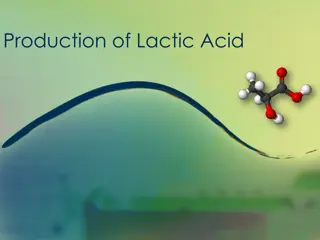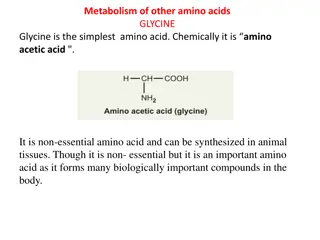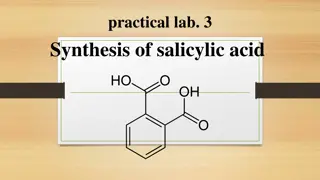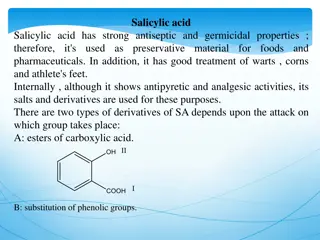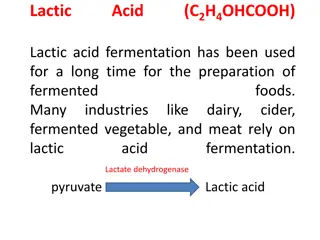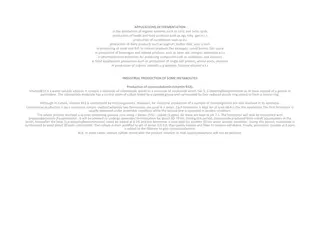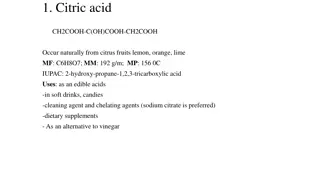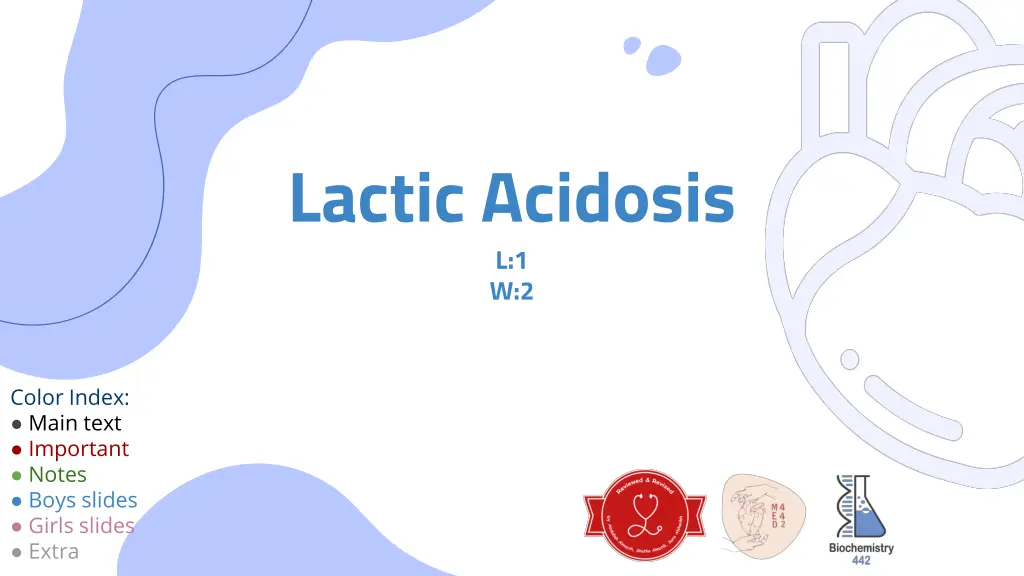
Understanding Lactic Acidosis in Metabolic Acid-Base Disorders
Explore the complexities of lactic acidosis, including its definition, causes, clinical effects, and diagnosis in metabolic acid-base disorders. Learn about lactate metabolism, anion gap assessment, blood gas results, and the impact of metabolic acidosis on the body. Gain insights into different types and mechanisms of lactic acidosis for comprehensive understanding and effective management.
Download Presentation

Please find below an Image/Link to download the presentation.
The content on the website is provided AS IS for your information and personal use only. It may not be sold, licensed, or shared on other websites without obtaining consent from the author. If you encounter any issues during the download, it is possible that the publisher has removed the file from their server.
You are allowed to download the files provided on this website for personal or commercial use, subject to the condition that they are used lawfully. All files are the property of their respective owners.
The content on the website is provided AS IS for your information and personal use only. It may not be sold, licensed, or shared on other websites without obtaining consent from the author.
E N D
Presentation Transcript
Lactic Acidosis L:1 W:2 Color Index: Main text Important Notes Boys slides Girls slides Extra
objectives Define metabolic acid-base disorders including lactic acidosis Understand the causes and clinical effects of metabolic acidosis and alkalosis Recall the lactate metabolism in the body Differentiate between the types of lactic acidosis Understand the clinical significance of measuring anion gap Discuss the causes and diagnosis of lactic acidosis in conditions such as myocardial infarction Overview Lactic acidosis Introduction to metabolic acid-base disorders Metabolic acidosis Metabolic alkalosis Definition Lactate metabolism in tissue Mechanisms involved in lactic acidosis Types and causes of lactic acidosis Diagnosis and treatment
Blood gas results Metabolic acid-base disorders It is a test that help us to know if it is metabolic acidosis or alkalosis by inspecting the HCO3 concentration It is the changes in bicarbonate concentration in the extracellular fluid (ECF) cause metabolic acid- base disorders. Occur due to high concentration or loss of H+ ions. This change of bicarbonatewill lead to either : Metabolic acidosis Metabolic alkalosis In both, the function of the body will be affected because of the change in PH Acidosis Alkalosis H+ elevated H+ decreased HCO3-increased HCO3 decreased Equation of Carbonic acid-Bicarbonate buffering system If HCO3-normal, so it is not metabolic Controlled by renal Controlled by respiratory CO2 H2CO3 H2O H+ HCO3- Metabolic alkalosis Metabolic acidosis
Anion gap It is the difference between the sum of : [ (Na+K) - (Cl+HCO3) ] Na+ andK+ (cations) And Cl and HCO3 (anions) It helps in assessing acid-base problems Diabetic ketoacidosis Metabolic acidosis Renal disease High anion gap occurs Normal anion gap (3-11) mEq/L More than 11 mEq/L ( acidosis ) High anion gap in : less than 3 mEq/L ( alkalosis ) Low anion gap Lactic acidosis Metabolic acidosis can be accompanied by a normalanion gap like in the case of (Chronic Diarrhea) because you will loss HCO3- and the Cl- will be high due to compensation of HCO3- Poisoning overdose
15 5. anions 20 cation anion gap anions acid anion gap acid anions acidosis. 5 Acidosis 15 In anions we only count HCO3 and cl ( we don't count protein for example )
Metabolic acidosis Clinical effects of acidosis It is the Reduction in bicarbonate (HCO3) conc. of ECF Hyperventilation is the compensatory physiological response to acidosis to remove CO2 Increased H+ conc. stimulates respiratory response Hyperventilation: deep, rapid, and gasping respiratory pattern Arrhythmia, cardiac arrest Loss of consciousness, coma, death Ingestion of H+ or drugs metabolized to acids production of H+ ions Causes Loss of HCO3-e.g chronic diarrhoea in Diarrhea Impaired excretion of H+ After compensation Before compensation
Metabolic alkalosis Clinical effects of alkalosis Increase in bicarbonate conc. in ECF Hypoventilation(depressed breathing) Increases PCO2 to compensate alkalosis Respiratory arrest Confusion, coma, death Causes Ingestion of sodium bicarbonate Loss of H+ ions in gastric fluid due to vomiting Potassium deficiencyas a result of diuretic therapy In hypokalemia cells will take H+ from ECF to inside the cell to become neutralied because K+ & H+ have the same charge thus less H+ in ECF and alkalosis
Mechanisms involved in Lactic acidosis Lactic acidosis Lactic acidosis happens when there is an increase in lactic acid conc. ( hyperlactemia ) or impaired lactic acid clearance . Lactate is unmeasured anion (measured anions are HCO and Cl ) therefore, it has High anion gap. Elevated conc. of plasma lactate is called lactic acidosis Occurs either due to Failure of circulatory system(hypoxia) type A Disorders of carbohydrate metabolism type B The enzyme that converts pyruvate to acetyl coA is not working so the pyruvate will be converted to lactic acid , causing hyperlactemia Lactic acidosis can occur Excessive tissue lactate production Impaired hepatic metabolism of lactate due to: Definition and causes are important
Lactate metabolism in tissue The body tissues produce ~ 1500 mmoles of lactate each day The lactate enters blood stream and metabolized mainly by the liver(Cori cycle) All tissues can produce lactate under anaerobicconditions. Pyruvate is converted to lactateby lactate dehydrogenase enzyme The skeletal muscles produce high amounts of lactate during vigorous exercise Lactate is metabolized inliver(60%)and kidney (30%) to glucose Some lactate is metabolized to CO2and water(Krebs cycle) The Cori Cycle Pyruvate + NADH + H+ In the muscle: Glucose is converted into lactate by anaerobic glycolysis. Lactate is released into the blood and is transported to the liver. In the liver: Lactate glucose (gluconeogenesis). Glucose is transported to the muscles (for energy again). Lactate dehydrogenase muscles Lactate + NAD+
Types and causes of lactic acidosis Type A Type B Due to: Hypoxia causes: Due to: inadequate supply of oxygen(hypoxia) to tissues (most common): Myocardial infarction Pulmonary embolism Uncontrolled hemorrhage (bleeding) Tissue hypoperfusion (shock, cardiac arrest, acute heart failure, etc.) Anaerobic muscular exercise impaired oxidative phosphorylation and decreased ATP synthesis,This produces lactate as a final product. disorders in carbohydrate metabolism. (Congenitallactic acidosis is due to deficiency of pyruvate dehydrogenase enzyme. (important) ) Chronic hepaticdisease accompanied by shock or bleeding. Liver failure. Drug intoxication (poisoning) To survive: Adaptive response: the cells switch to anaerobicglycolysis for ATP synthesis ,This produces lactate as a final product. The amount of oxygenrequired to recover from oxygen deficiency is called oxygen debt (definition)
Diagnosis and treatment Hyperlactemia: 2 5 mmols/L risk for lactic acidosis Diagnosis done by measuring blood lactate levels Severe lactic acidosis: > 5 mmols/L Treatment Avoiding sodium bicarbonate. In acidosis in general it s known that adding sodium bicarbonate will help to get PH back to its normal range but in lactic acidosis for unknown reasons it will make it worse by increasing lactic acidosis Restoring adequate tissue oxygen (Because most of the time the cause of lactic acidosis is hypoxia) Correcting the underlying conditions
Take home message Lactic acidosis can be caused by hypoxia, excessive production and impaired clearance of lactic acid. It carries clinical significance in the diagnosis of myocardial infarction, pulmonary embolism and other metabolic conditions
MCQs Q1 Reductionin bicarbonate conc. of ECF is : A.metabolic alkalosis B.metabolic acidosis C.respiratory alkalosis D.Because of loss of H+ Q2 Hypoventilation(depressed breathing) Increases PCO2 to compensate which condition : A.Metabolic alkalosis B.Metabolic acidosis C.Respiratory acidosis D.None of them Q3 this equation is : A.Metabolic alkalosis after compensation B.Metabolic acidosis after compensation C.metabolic acidosis before compensation D.Metabolic alkalosis before compensation
MCQs Q4 What can cause congenital Lactic Acidosis ? A.pyruvate dehydrogenase enzyme B.ATP synthase C.Lactate dehydrogenase D.phosphorylase Q5The amount of oxygen required to recover from oxygen deficiency is called? A.Alkalosis B.Lactic Acidosis C.oxygen debt D.Metabolic acidosis Q6The lactate enters blood stream and metabolized mainly by? A.liver B.kidney C.Intestine D.muscle
SAQs Q1 numerate the causes of metabolic alkalosis ? Q2 define Metabolic acidosis Q3 what is the compensatory physiological response to acidosis Q1: Loss of H+ ions in gastric fluid due to vomiting Ingestion of sodium bicarbonate Potassium deficiency as a result of diuretic therapy Q2: Reduction in bicarbonate conc. of ECF Q 3 : Hyperventilation
Our Team Leaders Team members Mashael Alsuliman Shahad Alsakar Arwa Alghamdi Mohammed Aljarba Raseel Alwehibi Mohammed Ibn Saqyan Roaa Alharbi Fatima Halawi Meshari Alshathri Razan Alasmari Mohammed Abdulaziz Alrashoud Wafa Alqhtani Amer Alghamdi Sarah Albenmousa Biochemksumed442@gmail.com









